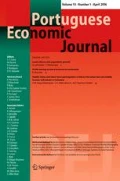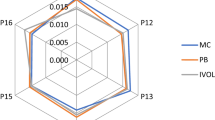Abstract
We examine risk profiles of the Portuguese stock market index component stocks using a novel approach to the classical capital asset pricing model (CAPM). Specifically, we estimate the CAPM via fractal regressions that allow studying the marginal effects at selected scales. In this way, we can reveal whether the risk is perceived differently by market participants with different investment horizons. Apart from the analysis itself, we provide new statistical insights into the issue of separating and comparing the scale-specific effects with statistical validity. We find several stocks deviating from an expected risk perception homogeneity across investment horizons. This is true for both analysed periods, i.e. before and after the global financial crisis. There are also several stocks that changed their relationship to the market portfolio in between, which has strong implications for possible portfolio construction. The proposed methodology is not limited to financial topics but can be used in any discipline where the scale-specific marginal effects might be of interest.


Similar content being viewed by others
Notes
It is also possible to find other studies of Portuguese stocks. For example, Alpalhão and Alves (2005) use a specific model to analyse how the Portuguese market behaves in relation to its risk exposure, concluding that the market has higher risk exposure than other European ones. Curto et al. (2003) and Ferreira and Dionísio (2014) analyse the existence of dependence in some stock markets, including the Portuguese one. Lobão and Azeredo (2018) investigate the momentum effect and value-growth effect in the Portuguese stock market.
References
Adedokun A, Olakojo S (2012) Test of capital asset pricing model: Evidence from Nigerian stock exchange. J Econ Theory 6:121–127
Alpalhão R, Alves P (2005) The Portuguese equity risk premium: What we know and what we don’t know. Appl Financ Econ 15(7):489–498
Alves P (2013) The Fama French model of the capital asset pricing model: international evidence. Int J BusFin Res 7(2):79–89
Arianos S, Carbone A (2009) Cross-correlation of long-range correlated series. J Stat Mech Theory Exp 3:P03037
Alessio E, Carbone A, Castelli G, Frappietro V (2002) Second-order moving average and scaling of stochastic time series. Eur Phys J B 27:197–200
Banz R (1981) The relationship between return and market value of common stocks. J Financ Econ 9(1):3–18
Barunik J, Kristoufek L (2010) On Hurst exponent estimation under heavy-tailed distributions. Physica A 389:3844–3855
Basu S (1977) Investment performance of common stocks in relation to their price-earnings ratios: a test of the efficient market hypothesis. J Financ 32:663–682
Breeden D (1979) An intertemporal asset pricing model with stochastic consumption and investment opportunities. J Financ Econ 7:265–296
Brock W, Hommes C (1998) Heterogeneous beliefs and routes to chais in a simple asset pricing model. J Econ Dyn Control 22:1235–1274
Curto J, Reis E, Esperança J (2003) Testes à forma fraca da eficiência dos mercados: aplicaçãoaosíndices PSI20, DAX e DJIA Economia (UniversidadeCatólica) XXVII:53–88
Fama E (1970) Efficient capital markets: a review of theory and empirical work. J Financ 25:383–417
Fama E (1991) Efficient capital markets: II. J Financ 46(5):1575–1617
Fama E, French K (1993) Common risk factors in the returns on stocks and bonds. J Financ Econ 33:3–56
Fama E, MacBeth J (1973) Risk, return, and equilibrium: Empirical tests. J Polit Econ 81:607–636
Ferreira P, Dionísio A (2014) Revisiting serial dependence in the stock markets of the G7 countries, Portugal, Spain and Greece. Appl Financ Econ 24(5):319–331
Ferreira P, Kristoufek L (2017) What is new about covered interest parity condition in the European Union? Evidence from fractal cross-correlation regressions. Physica A 486:554–566
Guermat C (2014) Yes, the CAPM is testable. J Bank Financ 46:31–42
Haque T, Mackay W (2016) A study of industry cost of equity in Australia using the Fama and French 5 factor model and the capital asset pricing model (CAPM): A pitch. Journal of accounting and. Manag Inf Syst 15(3):618–623
Hasan Z, Kamil A, Baten A (2013) Analyzing and estimating portfolio performance of Bangladesh stock market. Am J Appl Sci 10:139–146
He L, Chen S (2011) A new approach to quantify power-law cross-correlation and its application to commodity markets. Physica A 390:3806–3814
Ibbotson R, Sinquefield R (1976) Stocks, bonds, bills and inflation: Year-by-year historical returns (1926–1974). J Bus 49:11–47
Isakov D (1999) Is beta still alive? Conclusive evidence from the Swiss stock market. Eur J Financ 5:202–212
Jensen M (1968) The performance of mutual funds in the period 1945–1964. J Financ 23:389–416
Khudoykulov K, Khamidov O, Aktamov A (2015) Testing capital asset pricing model (CAPM) on the emerging Markets of the Europe. Spanish Journal of Rural Development VI(3)
Köseoğlu S, Mercangöz B (2013) Testing the validity of standard and zero Beta Capital asset pricing model in Istanbul stock exchange. Int J Bus Human Technol 3(7):58–67
Kristoufek L (2014a) Measuring correlations between non-stationary series with DCCA coefficient. Physica A 402:291–298
Kristoufek L (2014b) Detrending moving-average cross-correlation coefficient: Measuring cross-correlations between non-stationary series. Physica A 406:169–175
Kristoufek L (2015) Detrended fluctuation analysis as a regression framework: Estimating dependence at different scales. Phys Rev E 91:022802
Kristoufek L (2016) Scaling of dependence between foreign exchange rates and stock markets in Central Europe. Acta Phys Pol A 129:908–912
Kristoufek L (2018) Fractality in market risk structure: Dow Jones industrial components case. Chaos, Solitons Fractals 110:69–75
Lobão J, Azeredo M (2018) Momentum meets value investing in a small European market. Port Econ J 17(1):45–58
Lintner J (1965) The valuation of risk asset and the selection of risk investment in stock portfolio and capital budgets. Rev Econ Stat 47(1):13–37
Markowitz H (1952) Portfolio selection. J Financ 7(1):77–91
Merton R (1973) An intertemporal capital asset pricing model. Econometrica 41:867–887
Michailidis G, Tsopoglou S, Papanastasiou D, Mariola E (2006) Testing the capital asset pricing model (CAPM): the case of the emerging Greek securities market. Int Res J Financ Econ 4(1):78–91
Mossin J (1966) Equilibrium in a capital asset market. Econometrica 34(4):768–783
Peng C, Buldyrev V, Havlin S, Simons M, Stanley H, Goldberger A (1994) Mosaic organization of DNA nucleotides. Phys Rev E 49(2):1685–1689
Peters E (1991) Chaos and order in the capital markets - a new view of cycles, prices, and market volatility. John Wiley & Sons, Inc.
Peters E (1994) Fractal market analysis - applying Chaos theory to investment and analysis. John Wiley & Sons, Inc., New York
Podobnik B, Stanley H (2008) Detrended cross-correlations analysis: a new method for analyzing two nonstationary time series. Phys Rev Lett 100:084102
Roll R (1977) A critique of the asset pricing Theory’s tests. J Financ Econ 4:129–176
Sharpe W (1964) Capital asset prices: a theory of market equilibrium under ccondition of risk. J Financ 19(3):425–442
Squartini T, Almog A, Caldarelli G, Lelyveld I, Garlaschelli D, Cimini G (2017) Enhanced capital-asset pricing model for the reconstruction of bipartite financial networks. Phys Rev E 96:032315
Theiler J, Galdrikian B, Longtin A, Eubank S, Farmer J (1992) Using surrogate data to detect nonlinearity in time series. In: Casdagli M, Eubank S (eds) Nonlinear modelling and forecasting. Santa Fe Institute, Addison Wesley
Tsuji C (2017) An exploration of the time-varying Beta of the international capital asset pricing model: the case of the Japanese and the other Asia-Pacific stock markets. Accounting and Finance Research 6(2):86–93
Vandewalle N, Ausloos M (1998) Multi-affine analysis of typical currency exchange rates. Eur Phys J B 4:257–261
Vasicek O, McQuown J (1972) The efficient market model. Financ Anal J 28(5):71–84
Zebende G (2011) DCCA cross-correlation coefficient: Quantifying level of cross-correlation. Physica A 390:614–618
Zhang J, Wihlborg C (2005) Unconditional and Conditional CAPM: Evidence from the European Emerging Markets. In: Vainu J (ed) Development and Convergence of Financial Sector of New EU Members, Tallinn University of Technology 199–210
Acknowledgments
Paulo Ferreira is pleased to acknowledge financial support from Fundação para a Ciência e a Tecnologia (grant UID/ECO/04007/2013) and FEDER/COMPETE (POCI-01-0145-FEDER-007659). Ladislav Kristoufek gratefully acknowledges financial support of the Czech Science Foundation (project 17-12386Y).
Author information
Authors and Affiliations
Corresponding author
About this article
Cite this article
Kristoufek, L., Ferreira, P. Capital asset pricing model in Portugal: Evidence from fractal regressions. Port Econ J 17, 173–183 (2018). https://doi.org/10.1007/s10258-018-0145-5
Received:
Accepted:
Published:
Issue Date:
DOI: https://doi.org/10.1007/s10258-018-0145-5
Keywords
- Capital asset pricing model
- Detrended cross-correlation analysis
- Detrending moving-average cross-correlation analysis
- Fractal regressions
- Portugal




